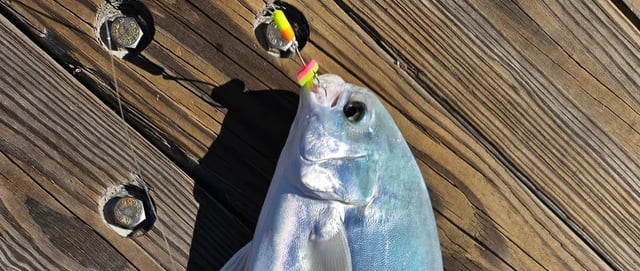When to Catch Pompano: A Seasonal Guide for Florida Anglers
Pompano are one of the most sought-after species for surf fishing enthusiasts in Florida. Known for their delicious flavor and thrilling fight, they are a favorite target for anglers up and down the state’s coasts. However, catching pompano is not just about showing up at the beach with a fishing rod. Timing plays a critical role in ensuring success. This guide dives deep into the best seasons, tides, and conditions for catching pompano in Florida, giving you all the information you need to plan your fishing trips effectively.
POMPANO
Kevin
12/24/20243 min read


Understanding Pompano Migration Patterns
Pompano are a migratory species, moving along the Atlantic and Gulf coasts in search of ideal water temperatures and food sources. Understanding their migration patterns is the first step to increasing your chances of landing one.
Seasonal Overview
• Spring (March–May):
Spring is one of the best times to target pompano in Florida. As water temperatures warm to their preferred range of 68–75°F, pompano begin migrating northward along both the Atlantic and Gulf coasts. During this time, they are actively feeding and are often found in the surf zone near sandy beaches.
• Summer (June–August):
Pompano fishing slows down in the summer as they move to deeper, cooler waters. While they can still be caught near passes and inlets, their presence in the surf becomes less consistent.
• Fall (October–December):
Another prime time for pompano fishing, fall sees the fish migrating southward as they prepare for winter. Cooler temperatures and an abundance of food in the surf zone make this a fantastic season to target them.
• Winter (January–February):
During the winter, pompano are primarily found in South Florida, where water temperatures remain warm enough to sustain them. Anglers in northern and central Florida may struggle to find pompano during this time.
Tides and Moon Phases
Understanding how tides and moon phases influence pompano behavior is key to planning your fishing trips.
Best Tidal Conditions
• Incoming Tides:
Pompano are most active during incoming tides, as the movement of water stirs up sand fleas and other prey, drawing the fish closer to shore.
• High Tide:
High tide is another productive time for pompano fishing, as they tend to feed closer to the beach.
Moon Phases
• New Moon and Full Moon:
During these phases, stronger tidal flows increase the availability of food in the surf zone, leading to heightened pompano activity.
• Quarter Moons:
While not as productive as new or full moons, quarter moons can still yield decent catches, especially when combined with favorable tides.
Daily Feeding Times
Pompano are most active during specific times of the day, which are influenced by light levels and water movement.
Morning and Evening Bites
• Early morning and late evening are the most reliable times to catch pompano. During these periods, low light levels encourage feeding activity, and tides are often more favorable.
Midday Fishing
• While pompano are less active during the middle of the day, they can still be caught if conditions are right, such as during an incoming tide or when baitfish are present in the surf.
Environmental Factors to Consider
Several environmental factors can influence pompano behavior, and paying attention to these can make or break your fishing trip.
Water Clarity
• Pompano prefer clean, clear water. If the water is murky due to storms or strong winds, they are less likely to feed in the surf zone.
Wind Direction
• Offshore winds (blowing from land to sea) create calmer surf conditions, which are ideal for pompano fishing.
Bait Presence
• Pompano follow their food. Sand fleas, small crabs, and shrimp are their primary prey, so targeting areas where these are abundant will increase your chances of success.
Tips for Tracking Seasonal Patterns
Use Fishing Apps and Tools
• Apps like FishTrack or Windy provide real-time updates on water temperatures, tides, and wind conditions, helping you plan your trips more effectively.
Monitor Local Reports
• Many local fishing forums and bait shops provide up-to-date information on pompano migrations and feeding activity. Checking these regularly can give you a significant advantage.
Keep a Fishing Log
• Maintaining a log of your fishing trips, including dates, conditions, and catches, can help you identify patterns over time and improve your success rate.
Conclusion
Timing is everything when it comes to catching pompano in Florida. By understanding their migration patterns, paying attention to tides and moon phases, and considering environmental factors, you can significantly improve your chances of landing these prized fish. Whether you’re fishing during the peak spring and fall seasons or targeting them in South Florida during the winter, careful planning and observation will make your pompano fishing trips more productive and enjoyable.